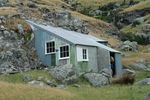ABCM/Alternative building construction methods/Rammed earth
| Alternative Building Construction Methods | |
|---|---|
| Alternative Building Construction Methods | Introduction | Solid timber | Steel frame | Straw bale | Polystyrene block | Log | Rammed earth | Aerated concrete | Expanded polystyrene metal clad panels | Key points | Assessment |
Rammed earth
Rammed earth walls are constructed by ramming a mixture of earth, with gravel, sand, silt and clay, into place between formwork. Ramming is done with manual or mechanical rammers.
Sand is added to most soils to reduce shrinkage which can otherwise be a problem. Stabilised rammed earth has 5-10% cement added to give extra strength and durability.
The mixture must be carefully mixed and almost dry. The formwork can be removed immediately after the wall is finished.
Earth buildings should not contain any organic matter. This will rot, allowing mould and fungi to grow, and also weakening the structure.
External walls are usually 30cm thick, and internal walls may be 20cm. Curved walls are possible but need more expensive formwork.
The appearance of rammed earth walls depends on the materials used. It often has a stratified look caused by the ramming process.For millennia people have built structures from earth. There are examples in the Middle East which date back to 8000 BC. One of the most impressive earth structures is the Great Wall of China. Throughout the world thousands of earth buildings over 500 years old are still in sound condition and inhabited. Currently it is estimated that up to half of the world's population—approximately three billion people on six continents — lives or works in buildings constructed of earth.
Where ever suitable soil was available, people have developed a local earth building tradition. Even though earth is an ancient building material, the earth building tradition has been kept alive in many countries and the technology is constantly being adapted to the needs of modern civilization. Many assume that it's only used for housing in poor rural areas—but there are examples of airports, embassies, hospitals, museums, and factories that are made of earth.
Over the last few decades many beautiful earth homes have been built in western countries. Many people are realizing that it is getting more and more important to develop a sustainable lifestyle in order to avoid a possible ecological crisis. In terms of sustainability, unstabilised earth surpasses any other building material, including timber, owing to its low carbon footprint, its longevity and its unlimited recyclability. Its many advantages speak for themselves. Reference Solid earth NZ
Mud brick (Adobe)
Mud bricks are laid similarly to conventional masonry.
Mud bricks are cast in moulds and allowed to dry out slowly in the air. Often straw or other fibres are added to help reduce cracking.
Any shrinkage occurs during this drying. New bricks can be trimmed and cut before they dry out too much.
Mud bricks are laid with a thick layer of mud mortar between them. This mortar is also rubbed over the walls to fill in any gaps and cracks.
Mud brick allows a greater range of soils to be used compared with rammed earth.
A temporary roof should be constructed to give shelter to the walls as they are being built.

